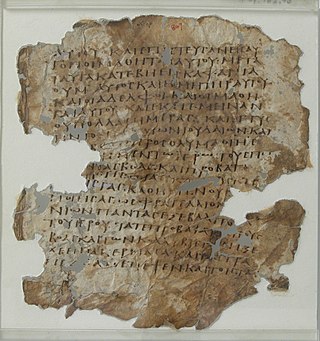
Uncial 0162, ε 023, is one vellum leaf of a Codex containing The Gospel of John in Greek. It has been paleographically assigned a 3rd or 4th century CE date.

Codex Tischendorfianus IV – designated by Γ or 036, ε 70 – is a Greek uncial manuscript of the Gospels, dated palaeographically to the 10th century. The manuscript is lacunose.

Codex Zacynthius (designated by siglum Ξ or 040 in the Gregory-Aland numbering; A1 in von Soden) is a Greek New Testament codex, dated paleographically to the 6th century. First thought to have been written in the 8th century, it is a palimpsest—the original (lower) text was washed off its vellum pages and overwritten in the 12th or 13th century. The upper text of the palimpsest contains weekday Gospel lessons (ℓ299); the lower text contains portions of the Gospel of Luke, deciphered by biblical scholar and palaeographer Tregelles in 1861. The lower text is of most interest to scholars.
Uncial 055, is a Greek uncial manuscript of the New Testament, dated paleographically to the 11th century. The codex contains a commentary with incomplete text of the four Gospels, on 303 parchment leaves.
Uncial 079, ε 16 (Soden), is a Greek uncial manuscript of the New Testament, dated paleographically to the 6th century.
Uncial 085, ε 23 (Soden), is a Greek uncial manuscript of the New Testament, dated palaeographically to the 6th century.
Uncial 089 in the Gregory-Aland numbering), ε 28 (Soden), is a Greek uncial manuscript of the New Testament, dated paleographically to the 6th century. The codex now is located at the Russian National Library in Saint Petersburg. It came to Russia from Sinai.
Uncial 0108, ε 60 (Soden), is a Greek uncial manuscript of the New Testament, dated paleographically to the 7th-century. Formerly it was labelled by Θd.
Uncial 0136, ε 91 (Soden), is a Greek-Arabic diglot uncial manuscript of the New Testament, dated palaeographically to the 9th century. Formerly it was labelled by Θh.
Minuscule 892, ε 1016 (Soden). It is a Greek minuscule manuscript of the New Testament, on 353 parchment leaves. It is dated palaeografically to the 9th century.
Uncial 0211, ε 051 (Soden), is a Greek uncial manuscript of the New Testament, dated paleographically to the 7th century.
Uncial 0243, is a Greek uncial manuscript of the New Testament. Paleographically it has been assigned to the 10th century.
Codex Ephesinus, minuscule 71, ε 253, is a Greek minuscule manuscript of the New Testament, on parchment, illuminated, and elegantly written. It is dated by the colophon to 1160. In the 15th century the manuscript was prepared for liturgical use. The scribal errors are not numerous, but it has many textual divergences from the common text. The Greek text of the codex is a representative of the Byzantine text-type, but the textual character of the codex is disputed by scholars since the 19th century.
Minuscule 99, ε 597, known as Codex Lipsiensis is a Greek minuscule manuscript of the New Testament, on parchment leaves. Palaeographically it has been assigned to the 15th or 16th century. The manuscript is very lacunose. It has marginalia and was adapted for liturgical use.
Minuscule 712, δ160, is a Greek minuscule manuscript of the New Testament, on parchment. Palaeographically it has been assigned to the 11th century. The manuscript has complex contents. Scrivener labelled it as 560e.
Lectionary 317 (Gregory-Aland), designated by siglum ℓ317 is a Greek manuscript of the New Testament, on parchment. Palaeographically it has been assigned to the 9th century. The manuscript has survived in a fragmentary condition.
Minuscule 925, ε 1450, is a 14th-century Greek minuscule manuscript of the New Testament on parchment. It has marginalia. The manuscript has survived in complete condition.
Minuscule 929, δ 478, is a 13th-century Greek minuscule manuscript of the New Testament on parchment. It has marginalia and was prepared for liturgical use. The manuscript has survived in complete condition.
Minuscule 933, ε 2004, is a 12th-century Greek minuscule manuscript of the New Testament on parchment. It has liturgical books, marginalia and was prepared for liturgical use. The manuscript has not survived in complete condition.
Minuscule 942, ε 1365 von Soden), is a 10th-century Greek minuscule manuscript of the New Testament on parchment. The manuscript has survived in complete condition.







